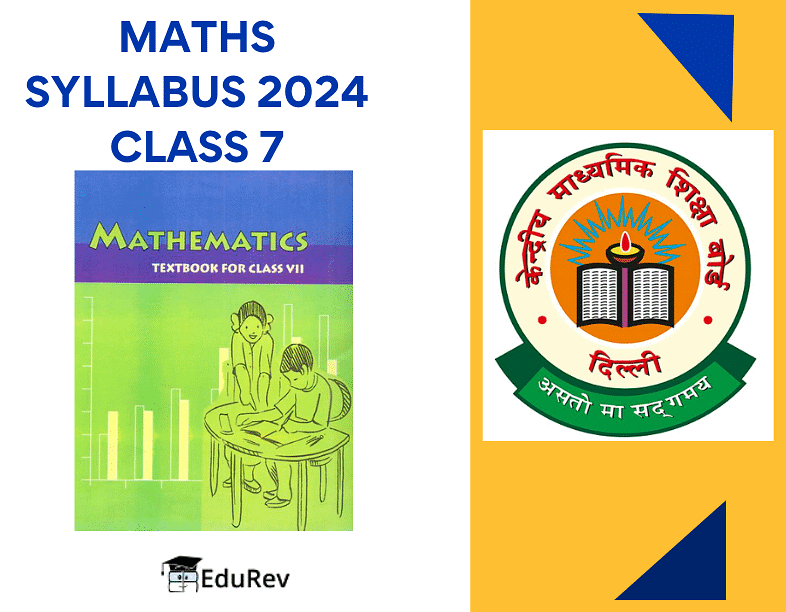Syllabus: Mathematics for Class 7 | Mathematics (Maths) Class 7 (Old NCERT) PDF Download
In Class 7 math, you will understand numbers, shapes, whole numbers, fractions, and decimals. you will also discover how to solve problems with letters and numbers mixed up (that's algebra!). Explore shapes like lines, angles, and triangles, and figure out how to compare amounts. They dive into practical stuff like measuring areas and handling data. Along the way, they find out about symmetry and how to imagine 3D shapes. It's like a fun journey where they learn a lot and get ready for harder math later on!

CBSE Class 7 Math Syllabus is designed to help students develop a strong foundation in the subject and prepare them for higher classes.
CBSE Class 7 Maths Syllabus
Chapter 1: Integers
Understanding integers is crucial as they form the foundation for many mathematical concepts and real-life applications. We will delve into operations like addition, subtraction, multiplication, and division involving integers, along with their properties and applications.
Chapter 2: Fractions and Equations
Fractions are fundamental in mathematics, representing parts of a whole. Equations, on the other hand, are mathematical statements asserting the equality of two expressions. In this chapter, we will unravel the intricacies of fractions, their operations, simplification, and their role in solving equations.
Chapter 3: Data Handling
Data handling involves collecting, organizing, analyzing, and interpreting data to draw meaningful conclusions. In this chapter, we will learn about different methods of data collection, presentation, and interpretation, including graphical representation and measures of central tendency.
Chapter 4: Simple Equation
Simple equations are mathematical statements containing one variable, which we aim to solve for. They are prevalent in various mathematical problems and real-world scenarios. In this chapter, we will delve into techniques for solving simple equations, including balancing methods, inverse operations, and algebraic manipulation.
Chapter 5: Lines and Angles
Lines and angles form the backbone of geometry, influencing shapes, patterns, and spatial relationships. In this chapter, we will explore the properties of lines and angles, including types of angles, angle relationships, parallel lines, and transversals.
Chapter 6: The Triangle and its Properties
Triangles are fundamental geometric shapes with rich properties and applications. In this chapter, we will delve into the properties of triangles, including types, angle relationships, congruence, and similarity.
Chapter 7: Comparing Quantities
Comparing quantities involves analyzing and evaluating the relationship between different amounts or measurements. In this chapter, we will explore methods for comparing quantities, including ratios, percentages, and proportions. Understanding how to compare quantities is essential for making informed decisions, and solving problems in business, finance, and everyday life.
Chapter 8: Rational Numbers
Rational numbers are numbers that can be expressed as the quotient of two integers, where the denominator is not zero. In this chapter, we will delve into the properties and operations involving rational numbers, including addition, subtraction, multiplication, division, and their applications. Understanding rational numbers is crucial for solving various mathematical problems and real-life situations.
Chapter 9: Perimeter and Area
Perimeter and area are fundamental measures used to quantify the size and shape of two-dimensional figures. In this chapter, we will explore methods for calculating perimeter and area of various shapes, including rectangles, squares, triangles, and circles. Understanding perimeter and area is essential in fields such as architecture, construction, and land surveying
Chapter 10: Algebraic Expressions
Algebraic expressions involve combinations of numbers, variables, and operations such as addition, subtraction, multiplication, and division. In this chapter, we will delve into simplifying, evaluating, and manipulating algebraic expressions, including polynomial expressions and algebraic identities.
Chapter 11: Exponents and Powers
Exponents and powers are mathematical notation used to represent repeated multiplication and its results. In this chapter, we will explore the properties and operations involving exponents and powers, including exponent rules, scientific notation, and applications in real-world scenarios. Understanding exponents and powers is crucial for advanced mathematical concepts and practical problem-solving.
Chapter 12: Symmetry
In this chapter, we will explore different types of symmetry, including line symmetry, rotational symmetry, and bilateral symmetry, along with their properties and applications in geometry, art, and design.
Chapter 13: Visualising Solid Shapes
Visualizing solid shapes involves understanding three-dimensional objects and their properties.In this chapter, we will explore methods for visualizing and analyzing solid shapes, including identifying faces, edges, and vertices, calculating volume and surface area, and applying spatial reasoning skills.
|
77 videos|386 docs|39 tests
|
FAQs on Syllabus: Mathematics for Class 7 - Mathematics (Maths) Class 7 (Old NCERT)
| 1. What topics are covered in the Mathematics syllabus for Class 7? |  |
| 2. How can I prepare for the Mathematics exam in Class 7? |  |
| 3. Are there any recommended resources or study materials for Class 7 Mathematics? |  |
| 4. How can I improve my problem-solving skills in Mathematics for Class 7? |  |
| 5. What are some effective study techniques for Mathematics in Class 7? |  |

















